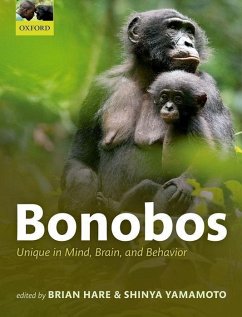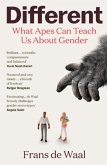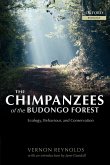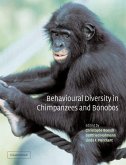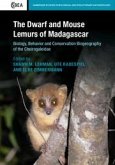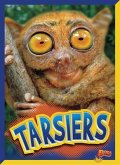Bonobos
Unique in Mind, Brain, and Behavior
Herausgeber: Hare, Brian; Yamamoto, Shinya
Bonobos
Unique in Mind, Brain, and Behavior
Herausgeber: Hare, Brian; Yamamoto, Shinya
- Gebundenes Buch
- Merkliste
- Auf die Merkliste
- Bewerten Bewerten
- Teilen
- Produkt teilen
- Produkterinnerung
- Produkterinnerung
Draws from cutting-edge science to illustrate the central role that bonobos play in testing hypotheses relating to the processes by which evolution shapes primate (including human) cognition.
Andere Kunden interessierten sich auch für
![Different Different]() Frans De WaalDifferent10,99 €
Frans De WaalDifferent10,99 €![Structure and Evolution of Invertebrate Nervous Systems Structure and Evolution of Invertebrate Nervous Systems]() Andreas Schmidt-RhaesaStructure and Evolution of Invertebrate Nervous Systems274,99 €
Andreas Schmidt-RhaesaStructure and Evolution of Invertebrate Nervous Systems274,99 €![The Chimpanzees of the Budongo Forest The Chimpanzees of the Budongo Forest]() Vernon ReynoldsThe Chimpanzees of the Budongo Forest125,99 €
Vernon ReynoldsThe Chimpanzees of the Budongo Forest125,99 €![Behavioural Diversity in Chimpanzees and Bonobos Behavioural Diversity in Chimpanzees and Bonobos]() Linda MarchantBehavioural Diversity in Chimpanzees and Bonobos115,99 €
Linda MarchantBehavioural Diversity in Chimpanzees and Bonobos115,99 €![The Dwarf and Mouse Lemurs of Madagascar The Dwarf and Mouse Lemurs of Madagascar]() The Dwarf and Mouse Lemurs of Madagascar143,99 €
The Dwarf and Mouse Lemurs of Madagascar143,99 €![The Gibbons The Gibbons]() Susan Lappan / Danielle Whittaker (ed.)The Gibbons340,99 €
Susan Lappan / Danielle Whittaker (ed.)The Gibbons340,99 €![Tarsiers Tarsiers]() Gail TerpTarsiers41,99 €
Gail TerpTarsiers41,99 €-
-
-
Draws from cutting-edge science to illustrate the central role that bonobos play in testing hypotheses relating to the processes by which evolution shapes primate (including human) cognition.
Hinweis: Dieser Artikel kann nur an eine deutsche Lieferadresse ausgeliefert werden.
Hinweis: Dieser Artikel kann nur an eine deutsche Lieferadresse ausgeliefert werden.
Produktdetails
- Produktdetails
- Verlag: Oxford University Press
- Seitenzahl: 300
- Erscheinungstermin: 7. Dezember 2017
- Englisch
- Abmessung: 249mm x 191mm x 23mm
- Gewicht: 862g
- ISBN-13: 9780198728511
- ISBN-10: 0198728514
- Artikelnr.: 48686483
- Herstellerkennzeichnung
- Libri GmbH
- Europaallee 1
- 36244 Bad Hersfeld
- gpsr@libri.de
- Verlag: Oxford University Press
- Seitenzahl: 300
- Erscheinungstermin: 7. Dezember 2017
- Englisch
- Abmessung: 249mm x 191mm x 23mm
- Gewicht: 862g
- ISBN-13: 9780198728511
- ISBN-10: 0198728514
- Artikelnr.: 48686483
- Herstellerkennzeichnung
- Libri GmbH
- Europaallee 1
- 36244 Bad Hersfeld
- gpsr@libri.de
Dr Brian Hare is an associate professor of Evolutionary Anthropology and a member of the Center for Cognitive Neuroscience at Duke University in the United States. Since 2007, he has published over two dozen peer-reviewed empirical papers on the cognition, behavior, physiology, morphology, and evolution of the bonobo. He has studied bonobos in zoos, African sanctuaries and in the wild. His research focuses on identifying unique cognitive traits as well as understanding evolutionary processes that produce them. Dr Shinya Yamamoto is an associate professor at Kobe University in Japan. He has published research on both wild and captive chimpanzees. More recently he began studying the behavior of wild bonobos at the Wamba field site in the Democratic Republic of Congo. His research concentrates on the evolution of cooperation, culture, and understanding others.
* FOREWORD
* 1: Brian Hare and Shinya Yamamoto: Minding the bonobo mind
* 2: Takeshi Furuichi: Female contributions to the peaceful nature of
bonobo society
* 3: Martin Surbeck and Gottfried Hohmann: Affiliations, aggressions
and an adoption: male-male relationships in wild bonobos
* 4: Kara Walker and Brian Hare: Bonobo baby dominance: did female
defense of offspring lead to reduced male aggression?
* 5: Elisabetta Palagi and Elisa Demuru: Pan Paniscus or Pan Ludens?
Bonobos, playful attitude and social tolerance
* 6: Christopher Krupenye, Evan L. MacLean, and Brian Hare: Does the
bonobo have a (chimpanzee-like) theory of mind?
* 7: Michael Tomasello: What did we learn from the ape language
studies?
* 8: Zanna Clay and Emilie Genty: Natural communication in bonobos:
insights into social awareness and the evolution of language
* 9: Shinya Yamamoto and Takeshi Furuichi: Courtesy food sharing
characterized by begging for social bonds in wild bonobos
* 10: Jingzhi Tan and Brian Hare: Prosociality among non-kin in bonobos
and chimpanzees compared
* 11: Alexandra G. Rosati: Ecological variation in cognition: insights
from bonobos and chimpanzees
* 12: Josep Call: Bonobos, chimpanzees and tools: integrating
species-specific psychological biases and socio-ecology
* 13: Nicky Staes, Marcel Eens, Alexander Weiss, and Jeroen M.G.
Stevens: Bonobo personality: age and sex effects and links with
behavior and dominance
* 14: William D. Hopkins, Cheryl D. Stimpson, and Chet C. Sherwood:
Social cognition and brain organization in chimpanzees (Pan
troglodytes) and bonobos (Pan paniscus)
* 15: Brian Hare and Vanessa Woods: Cognitive comparisons of genus Pan
support bonobo self-domestication
* 16: Hiroyuki Takemoto, Yoshi Kawamoto, and Takeshi Furuichi: The
formation of Congo river and the origin of bonobos: a new hypothesis
* 17: J. Nackoney, J. Hickey, D. Williams, C. Facheux, T. Furuichi, and
J. Dupain: Geospatial information informs bonobo conservation efforts
* 18: Lisa J. Faust, Claudine André, Raphaël Belais, Fanny Minesi, Zjef
Pereboom, Kerri Rodriguez, and Brian Hare: Bonobo population
dynamics: past patterns and future predictions for the Lola ya Bonobo
population using demographic modeling
* AFTERWORD
* 1: Brian Hare and Shinya Yamamoto: Minding the bonobo mind
* 2: Takeshi Furuichi: Female contributions to the peaceful nature of
bonobo society
* 3: Martin Surbeck and Gottfried Hohmann: Affiliations, aggressions
and an adoption: male-male relationships in wild bonobos
* 4: Kara Walker and Brian Hare: Bonobo baby dominance: did female
defense of offspring lead to reduced male aggression?
* 5: Elisabetta Palagi and Elisa Demuru: Pan Paniscus or Pan Ludens?
Bonobos, playful attitude and social tolerance
* 6: Christopher Krupenye, Evan L. MacLean, and Brian Hare: Does the
bonobo have a (chimpanzee-like) theory of mind?
* 7: Michael Tomasello: What did we learn from the ape language
studies?
* 8: Zanna Clay and Emilie Genty: Natural communication in bonobos:
insights into social awareness and the evolution of language
* 9: Shinya Yamamoto and Takeshi Furuichi: Courtesy food sharing
characterized by begging for social bonds in wild bonobos
* 10: Jingzhi Tan and Brian Hare: Prosociality among non-kin in bonobos
and chimpanzees compared
* 11: Alexandra G. Rosati: Ecological variation in cognition: insights
from bonobos and chimpanzees
* 12: Josep Call: Bonobos, chimpanzees and tools: integrating
species-specific psychological biases and socio-ecology
* 13: Nicky Staes, Marcel Eens, Alexander Weiss, and Jeroen M.G.
Stevens: Bonobo personality: age and sex effects and links with
behavior and dominance
* 14: William D. Hopkins, Cheryl D. Stimpson, and Chet C. Sherwood:
Social cognition and brain organization in chimpanzees (Pan
troglodytes) and bonobos (Pan paniscus)
* 15: Brian Hare and Vanessa Woods: Cognitive comparisons of genus Pan
support bonobo self-domestication
* 16: Hiroyuki Takemoto, Yoshi Kawamoto, and Takeshi Furuichi: The
formation of Congo river and the origin of bonobos: a new hypothesis
* 17: J. Nackoney, J. Hickey, D. Williams, C. Facheux, T. Furuichi, and
J. Dupain: Geospatial information informs bonobo conservation efforts
* 18: Lisa J. Faust, Claudine André, Raphaël Belais, Fanny Minesi, Zjef
Pereboom, Kerri Rodriguez, and Brian Hare: Bonobo population
dynamics: past patterns and future predictions for the Lola ya Bonobo
population using demographic modeling
* AFTERWORD
* FOREWORD
* 1: Brian Hare and Shinya Yamamoto: Minding the bonobo mind
* 2: Takeshi Furuichi: Female contributions to the peaceful nature of
bonobo society
* 3: Martin Surbeck and Gottfried Hohmann: Affiliations, aggressions
and an adoption: male-male relationships in wild bonobos
* 4: Kara Walker and Brian Hare: Bonobo baby dominance: did female
defense of offspring lead to reduced male aggression?
* 5: Elisabetta Palagi and Elisa Demuru: Pan Paniscus or Pan Ludens?
Bonobos, playful attitude and social tolerance
* 6: Christopher Krupenye, Evan L. MacLean, and Brian Hare: Does the
bonobo have a (chimpanzee-like) theory of mind?
* 7: Michael Tomasello: What did we learn from the ape language
studies?
* 8: Zanna Clay and Emilie Genty: Natural communication in bonobos:
insights into social awareness and the evolution of language
* 9: Shinya Yamamoto and Takeshi Furuichi: Courtesy food sharing
characterized by begging for social bonds in wild bonobos
* 10: Jingzhi Tan and Brian Hare: Prosociality among non-kin in bonobos
and chimpanzees compared
* 11: Alexandra G. Rosati: Ecological variation in cognition: insights
from bonobos and chimpanzees
* 12: Josep Call: Bonobos, chimpanzees and tools: integrating
species-specific psychological biases and socio-ecology
* 13: Nicky Staes, Marcel Eens, Alexander Weiss, and Jeroen M.G.
Stevens: Bonobo personality: age and sex effects and links with
behavior and dominance
* 14: William D. Hopkins, Cheryl D. Stimpson, and Chet C. Sherwood:
Social cognition and brain organization in chimpanzees (Pan
troglodytes) and bonobos (Pan paniscus)
* 15: Brian Hare and Vanessa Woods: Cognitive comparisons of genus Pan
support bonobo self-domestication
* 16: Hiroyuki Takemoto, Yoshi Kawamoto, and Takeshi Furuichi: The
formation of Congo river and the origin of bonobos: a new hypothesis
* 17: J. Nackoney, J. Hickey, D. Williams, C. Facheux, T. Furuichi, and
J. Dupain: Geospatial information informs bonobo conservation efforts
* 18: Lisa J. Faust, Claudine André, Raphaël Belais, Fanny Minesi, Zjef
Pereboom, Kerri Rodriguez, and Brian Hare: Bonobo population
dynamics: past patterns and future predictions for the Lola ya Bonobo
population using demographic modeling
* AFTERWORD
* 1: Brian Hare and Shinya Yamamoto: Minding the bonobo mind
* 2: Takeshi Furuichi: Female contributions to the peaceful nature of
bonobo society
* 3: Martin Surbeck and Gottfried Hohmann: Affiliations, aggressions
and an adoption: male-male relationships in wild bonobos
* 4: Kara Walker and Brian Hare: Bonobo baby dominance: did female
defense of offspring lead to reduced male aggression?
* 5: Elisabetta Palagi and Elisa Demuru: Pan Paniscus or Pan Ludens?
Bonobos, playful attitude and social tolerance
* 6: Christopher Krupenye, Evan L. MacLean, and Brian Hare: Does the
bonobo have a (chimpanzee-like) theory of mind?
* 7: Michael Tomasello: What did we learn from the ape language
studies?
* 8: Zanna Clay and Emilie Genty: Natural communication in bonobos:
insights into social awareness and the evolution of language
* 9: Shinya Yamamoto and Takeshi Furuichi: Courtesy food sharing
characterized by begging for social bonds in wild bonobos
* 10: Jingzhi Tan and Brian Hare: Prosociality among non-kin in bonobos
and chimpanzees compared
* 11: Alexandra G. Rosati: Ecological variation in cognition: insights
from bonobos and chimpanzees
* 12: Josep Call: Bonobos, chimpanzees and tools: integrating
species-specific psychological biases and socio-ecology
* 13: Nicky Staes, Marcel Eens, Alexander Weiss, and Jeroen M.G.
Stevens: Bonobo personality: age and sex effects and links with
behavior and dominance
* 14: William D. Hopkins, Cheryl D. Stimpson, and Chet C. Sherwood:
Social cognition and brain organization in chimpanzees (Pan
troglodytes) and bonobos (Pan paniscus)
* 15: Brian Hare and Vanessa Woods: Cognitive comparisons of genus Pan
support bonobo self-domestication
* 16: Hiroyuki Takemoto, Yoshi Kawamoto, and Takeshi Furuichi: The
formation of Congo river and the origin of bonobos: a new hypothesis
* 17: J. Nackoney, J. Hickey, D. Williams, C. Facheux, T. Furuichi, and
J. Dupain: Geospatial information informs bonobo conservation efforts
* 18: Lisa J. Faust, Claudine André, Raphaël Belais, Fanny Minesi, Zjef
Pereboom, Kerri Rodriguez, and Brian Hare: Bonobo population
dynamics: past patterns and future predictions for the Lola ya Bonobo
population using demographic modeling
* AFTERWORD

